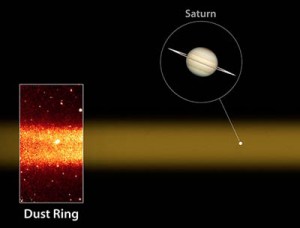King Ring
Just when you thought Saturn’s ring situation couldn’t get any cooler than the recent equinox photos by Cassini, make way for the mega-ring. Astronomers Anne Verbiscer, Michael Skrutskie, and Douglas Hamilton just announced that they’ve discovered a fantastically huge ring around Saturn. Their tool…
Just when you thought Saturn's ring situation couldn't get any cooler than the recent equinox photos by Cassini, make way for the mega-ring. Astronomers Anne Verbiscer, Michael Skrutskie, and Douglas Hamilton just announced that they've discovered a fantastically huge ring around Saturn. Their tool was the Spitzer Space Telescope, which orbits the sun in an Earth-trailing orbit about 66 million miles away from us.
For years astronomers have wondered why Iapetus, one of Saturn's many moons, appears encrusted on one side with material dark as asphalt, while the rest of the moon is quite bright. Turns out it may be getting a steady pie-in-the-face from another Saturnian moon, Phoebe, associated with the debris in the ring.
Phoebe's a bit of a rogue, a very dark moon that orbits way out from Saturn—about eight million miles—and in the opposite direction of most of the planet's other moons. By using Spitzer's super-cold instruments that can detect infrared radiation from objects, or in this case fields of debris, that are a couple hundred degrees below zero F, Verbiscer and her colleagues found that Phoebe was orbiting within an enormous ring of fine particles no one had ever detected. Some of the ring's debris probably falls onto Iapetus, which orbits just inside it, and may account for the moon's yin-yang look. For a high-resolution version of the image below, click here.

The matter in the mega-ring is tiny—most objects are specs of dust about ten microns across. They're also diffuse, with a distribution of only about 30 grains per cubic mile. If you ended up in the ring, you wouldn't even know it. "Cassini flew right through it on its way to Saturn," says Verbiscer of the spacecraft's arrival in the summer of 2004. "The ring is so big, the spacecraft had to keep flying another two weeks inside the ring before it even got to orbital insertion."

Since then, Cassini's orbits have kept it well inside the ring, which is about 300 Saturns in diameter, and about 20 Saturns thick. Really, more like a doughnut than the planet's standard rings. Like Phoebe's orbital plane, the big ring is inclined 27 degrees to the planet's other rings.
Will Verbiscer soon point Spitzer's chilly sensors at Jupiter next, in search of a Jovian mega-ring? She chuckles. "It's a logical next step, isn't it?" But, she adds, "No formal plans at this point."
For years astronomers have wondered why Iapetus, one of Saturn's many moons, appears encrusted on one side with material dark as asphalt, while the rest of the moon is quite bright. Turns out it may be getting a steady pie-in-the-face from another Saturnian moon, Phoebe, associated with the debris in the ring.
Phoebe's a bit of a rogue, a very dark moon that orbits way out from Saturn—about eight million miles—and in the opposite direction of most of the planet's other moons. By using Spitzer's super-cold instruments that can detect infrared radiation from objects, or in this case fields of debris, that are a couple hundred degrees below zero F, Verbiscer and her colleagues found that Phoebe was orbiting within an enormous ring of fine particles no one had ever detected. Some of the ring's debris probably falls onto Iapetus, which orbits just inside it, and may account for the moon's yin-yang look. For a high-resolution version of the image below, click here.

The matter in the mega-ring is tiny—most objects are specs of dust about ten microns across. They're also diffuse, with a distribution of only about 30 grains per cubic mile. If you ended up in the ring, you wouldn't even know it. "Cassini flew right through it on its way to Saturn," says Verbiscer of the spacecraft's arrival in the summer of 2004. "The ring is so big, the spacecraft had to keep flying another two weeks inside the ring before it even got to orbital insertion."

Since then, Cassini's orbits have kept it well inside the ring, which is about 300 Saturns in diameter, and about 20 Saturns thick. Really, more like a doughnut than the planet's standard rings. Like Phoebe's orbital plane, the big ring is inclined 27 degrees to the planet's other rings.
Will Verbiscer soon point Spitzer's chilly sensors at Jupiter next, in search of a Jovian mega-ring? She chuckles. "It's a logical next step, isn't it?" But, she adds, "No formal plans at this point."